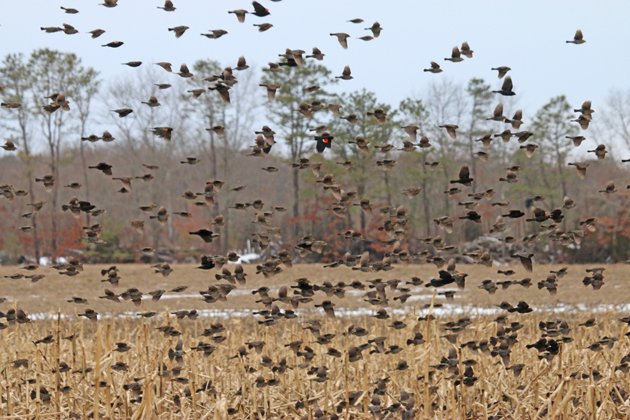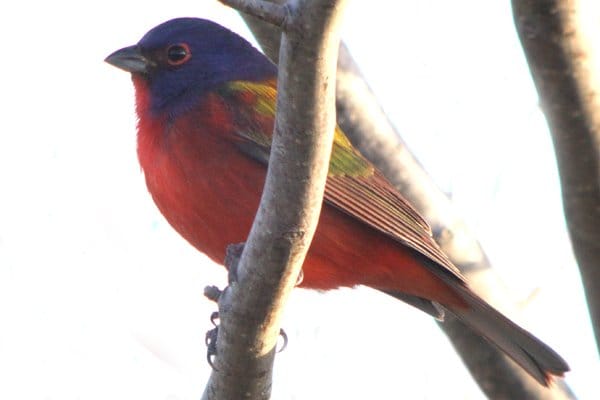
A recent comment thread on Facebook about absurdly high counts of some species in the eBird database got me curious. Who has seen the most Green Herons at one time? Painted Buntings? Gyrfalcons? What is the most of any one species that has ever been reported at one time? And how reliable is this data? Once you start down such a rabbit-hole it is difficult to stop the plunge into full on data-nerd mode.
Before I continue and get into some interesting numbers I should point out that the high counts listed here are all the highest numbers ever reported to eBird and confirmed by an eBird reviewer. Obviously, not all bird records have been reported to eBird. Also obvious is that there has to be some level of trust for some of these records to be considered accurate. Counting huge numbers of birds is very difficult and the general goal of observers is to at least get within an order of magnitude, which, when the numbers are ten or a hundred is relatively easy but when you are talking about 100,000 birds or a million birds things can get a bit more difficult. After all, have you ever counted to a million? Even by 1,000s? I didn’t think so. All that said, checking out extraordinary records, which these are by definition, is pretty neat.
Also, if you are interested in looking at these records yourself head on over to eBird, click “Explore Data,” then “Explore Region,” choose “World” as your region, and click the “High Count” tab. Beware! You might get addicted to this stuff: I have and it’s not pretty. Let’s take a look at some of what I found so you can make an informed decision as to if this is something you want to get involved in.
The most Green Herons ever reported is 3,000. The checklist is from 2005 in Nicaragua and the observer who wrote the notes, David Fraser, one of three observers named on the checklist, freely acknowledged that the number is an estimate:
Actual counts difficult to do given the numbers, for the commonest species (Neotropical Cormorant; Great and Snowy Egrets, Little Blue and Green Herons, Laughing Gull, Lesser Yellow-headed Vulture, Northern Jacana) the numbers here are estimates.
Still, even assuming that the number is off by 500 that would still be 2,500 Green Herons, which is a huge number! Of course, the party covered 24 kilometers and took six hours to do it, so it’s not like all the herons were lined up together but still, that is a huge number of herons!
The most Painted Buntings ever reported is 200. The observer, Brush Freeman, covered 71 miles of Texas in six hours in June of 2013 and didn’t even add notes about the world’s largest count of Painted Buntings which, considering the evenness of the number, must be an estimate.
Just one Painted Bunting is enough to make me lose my mind. 200? I would never recover!
The most Gyrfalcons ever reported is 8. Which, to be honest, is kind of disappointing. But I bet Eddie Shea, who reported the eight Gyrfalcons from Alaska in June of 2010, was pretty pleased to see them. Honestly though, I was hoping for a number like one hundred. Now that would be something!
The most of any species ever reported is 76,000,000 Brown-headed Cowbirds. It happened during a Christmas Bird Count in Louisiana in 1984. The same count had 15,000,000 Red-winged Blackbirds and 10,000,000 Common Grackles. The notes on this exceptional number of birds is “counted blackbirds in aggregates of 100,000 and estimated ratios of species every 10 minutes.” That means that the observer counted 1,010 aggregates of 100,000 birds. That is totally nuts. These numbers are clearly very rough estimates and, as was pointed out on the discussion on the Facebook eBird discussion group page, 76 million would be over 60% of the known population of the species of Brown-headed Cowbird. It seems unlikely, but, again, observers are striving to get within an order of magnitude when dealing with counts and if the number was 50 million or 76 million doesn’t matter so much as the fact that there was an insanely large number of cowbirds in Louisiana for that Christmas Bird Count.
Other fun numbers I dug up? The New Yorker in me likes that the world high counts of Black Scoter, Surf Scoter, and White-winged Scoter were all made off Montauk Point in January and February of 2011. Sharon Stiteler, the Birdchick, has the all time high count of Canvasback, in Iowa back in 2010. Some crazy guy reported eight of a mythical woodpecker (and even shared an obviously fabricated video of one of them). The most of any single species of hummingbird ever reported is 906 Anna’s Hummingbirds. The most owls? How about 248 Northern Saw-whet Owls banded in one night?!?!?!
I could go on forever. This stuff is fascinating. If you don’t hear from me within a week or two please send out a search party…or go look for yourself! If you find something cool, please let me know in the comments.














Well, at least the CGI of the “mythical woodpecker video” was better than your messing around with Black-crowned Night-heron pictures.
Down the nerd trail: while record numbers are fun, of course they obviously depend on the area covered and therefore are difficult to compare. The green heron number in your example broken down to 24 km equals roughly 1 heron every 10 m of trail, which is reasonable if the wetland stretched for many 100 m on both sides of the path. However, seeing 3000 along 24 km of trail may not be as special as counting 20 at Jamaica Bay, NY. A friend once had a huge online discussion with a data reviewer because she claimed around 30 stonechats for one area. Now, the reviewer remarked that this was the largest number ever recorded in Germany and that they don’t occur in flocks and whether she was sure they had not been whinchats. To which she replied that they were not in a single flock but in small groups or singles spread out over many km² but that the online data portal didn’t offer any alternative as to give the total, etc. etc.
And of course, numbers / estimates vary huuuugely amongst observers. Once birding with a friend (a different one), we flushed a small flock of sparrows that he estimated at 30, I estimated at 75, and since this was so way off, we tracked the flock down and counted 95.
And then of course,… no, I’ve ventured too far down into nerdland already, I’ll leave the rest for later.
Glancing through New Jersey’s high counts, I see that someone (the observer field is blank) reported exactly 999 House Sparrows at Garret Mountain. (The world record is 6063, which is lower than I would have expected.) I also can’t imagine seeing 55,110 Common Redpolls in one day, but someone reported that in Quebec just a month ago. Or 35,000 Goldcrests!
I agree with Jochen’s points about the variation in area covered and individual observers. I also wonder if some of the really big numbers that are weirdly precise shouldn’t be rounded more. Did someone really count 5,000,075 individual robins?
I’d be just as interested (if not more) in learning the records of bird species seen in one field of view at one point in time … 200 Painted Buntings over 6 hours is cool, but if 25 were all visible at once, to me that’s even more special.
John, 999 is a number I can trust because it suggests the observer actually did some counting. However, numbers like 750, 1000 etc. always make me think that the observer saw a lot of birds, was overwhelmed by the experience and wrote down whatever number appeared “overwhelming” to them, which is then very subjective.
And I absolutely agree about the rounding. In your example – and this is very common – the observer likely saw a huuuuge flock estimated at 5,000,000 and later saw a smaller flock of 75. doesn’t make that much sense.